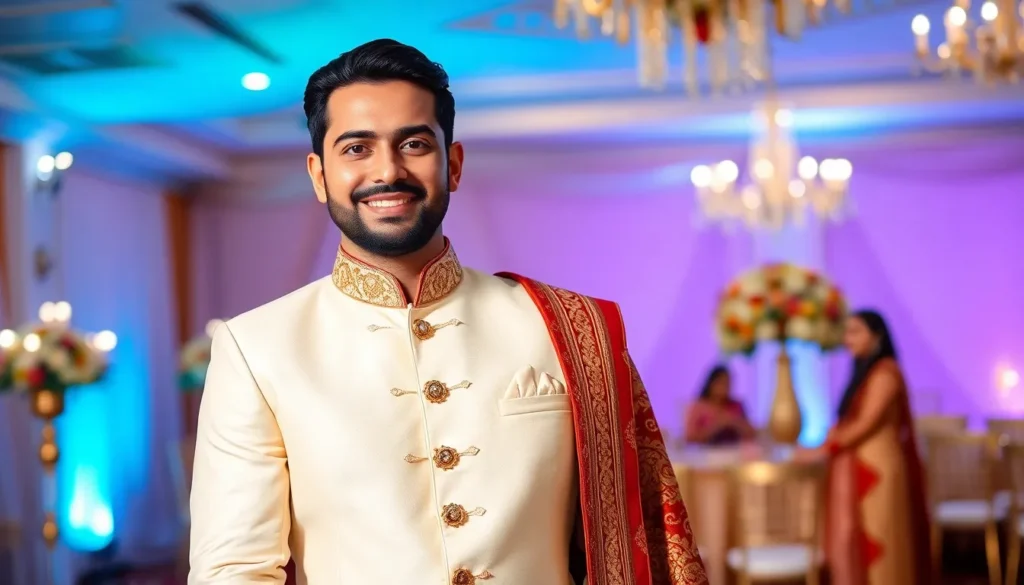When it comes to elevating your formal wardrobe, nothing quite matches the timeless elegance of a sherwani with shawl for men. This classic combination has been the go-to choice for grooms, wedding guests, and formal event attendees for centuries, and we can see why it continues to dominate the fashion scene today.
The beauty of pairing a sherwani with a shawl lies in its versatility and sophisticated appeal. Whether you’re attending a wedding ceremony, cultural celebration, or any formal gathering, this ensemble creates an instantly polished look that commands attention. We’ve seen how the right shawl can transform a simple sherwani into a statement piece that exudes confidence and style.
What makes this combination truly special is how it balances traditional craftsmanship with modern fashion sensibilities. From intricate embroidery to luxurious fabrics, we’ll explore everything you need to know about choosing, styling, and wearing this iconic menswear combination that never goes out of style.
Classic Ivory Sherwani With Embroidered Pashmina Shawl
The classic ivory sherwani paired with an embroidered pashmina shawl represents the pinnacle of sophisticated menswear for special occasions. This timeless combination offers unmatched elegance that works beautifully for weddings and formal celebrations.
Traditional Gold Thread Work Details
Zardozi embroidery creates stunning visual appeal on ivory fabric through intricate metallic threadwork that catches light beautifully. Master artisans use real gold and silver threads to create elaborate paisley motifs, floral patterns, and geometric designs across the shawl’s surface. Hand-stitched borders feature dense thread work that typically takes 15-20 hours to complete per shawl, showcasing exceptional craftsmanship.
Silk thread accents complement the gold work by adding depth and texture to the overall design. Artisans incorporate French knots, chain stitches, and couching techniques to create raised patterns that feel luxurious to the touch. Mirror work details called mukesh add sparkle through tiny reflective pieces strategically placed within the embroidered motifs.
Traditional motifs include peacock feathers, vine patterns, and Mughal-inspired designs that honor centuries-old textile traditions. Contemporary variations feature modern interpretations of classic patterns while maintaining the sophisticated aesthetic that makes ivory sherwanis so coveted.
Matching Churidar Pants Styling
Fitted churidar pants in matching ivory silk create a cohesive look that elongates the silhouette and maintains formal elegance. We recommend choosing pants with subtle pleating at the ankles that creates the traditional gathered effect without appearing bulky. Tone-on-tone coordination ensures the pants complement rather than compete with the sherwani’s embellished details.
Contrast piping along the side seams adds visual interest while maintaining the outfit’s refined appearance. Silver or gold piping works exceptionally well with ivory fabric, creating definition without overwhelming the overall aesthetic. Proper fit measurements require the pants to sit comfortably at the natural waist while tapering gradually toward the ankles.
Fabric selection matters significantly for churidar styling, with silk and cotton blends offering the best drape and comfort for extended wear. Premium fabrics hold their shape throughout long celebrations while allowing natural movement during ceremonies and festivities.
Royal Blue Velvet Sherwani With Contrasting Silk Shawl
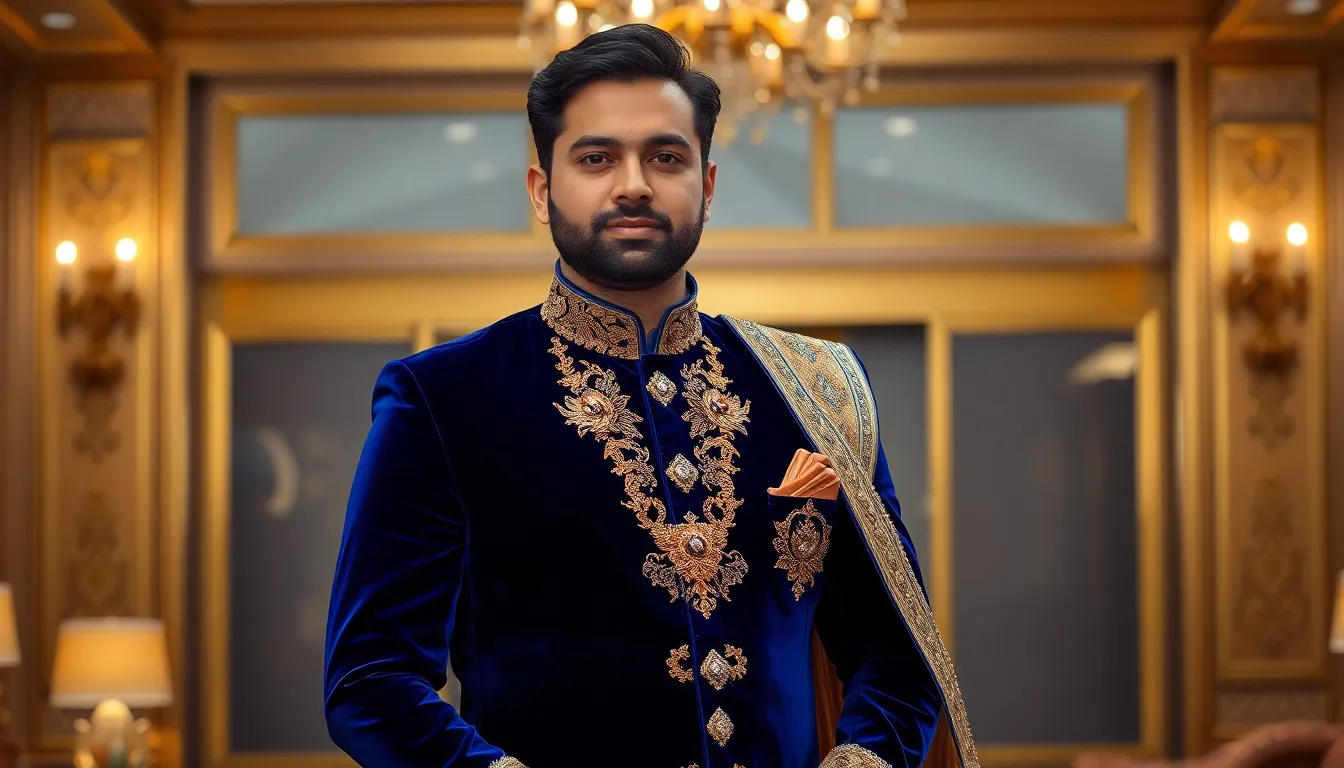
Royal blue velvet sherwanis create a luxurious foundation that transforms any formal occasion into a memorable experience. We’ve observed that this deep, rich color choice offers exceptional versatility while maintaining its regal appeal across different lighting conditions and settings.
Rich Texture Combination Benefits
Velvet’s plush texture provides warmth and visual depth that makes royal blue sherwanis perfect for cooler weather events. Silk shawls in contrasting shades create a smooth, glossy balance against the velvet’s richness, adding sophistication through thoughtful fabric pairing. We recommend choosing lighter complementary colors for the silk shawl to achieve optimal contrast without overwhelming the ensemble.
Layered sophistication emerges when these two premium fabrics work together harmoniously. Embroidered silk shawls serve as the outfit’s centerpiece, drawing attention through intricate patterns while emphasizing cultural heritage. The fluid drape of silk complements velvet’s structured appearance, creating visual interest that highlights both tradition and contemporary style preferences.
Temperature regulation becomes easier with this fabric combination, as velvet provides insulation while silk offers breathability. We’ve found that the textural contrast enhances the overall look’s refinement, making it suitable for extended wear during lengthy formal events. Pattern mixing works exceptionally well when the shawl features detailed embroidery that coordinates with the sherwani’s royal blue base.
Formal Event Appropriateness
Wedding ceremonies and receptions represent ideal occasions for royal blue velvet sherwanis with contrasting silk shawls. Grooms frequently choose this combination for its ability to command attention while respecting traditional dress codes. We’ve noticed that wedding guests also favor this ensemble for its perfect balance of elegance and cultural significance.
Cultural celebrations benefit from this sophisticated pairing because it demonstrates respect for ceremonial customs. Evening events particularly suit this combination, as the rich textures photograph beautifully under formal lighting conditions. Reception venues with traditional décor complement the royal blue and silk contrast, creating cohesive visual harmony throughout the celebration.
Formal business events and award ceremonies also welcome this distinguished look. We recommend this combination for men attending important ceremonies where graceful presentation reflects personal and professional standards. The shawl’s presence signals awareness of cultural importance while the royal blue velvet conveys confidence and refined taste.
Burgundy Brocade Sherwani With Coordinated Woolen Shawl
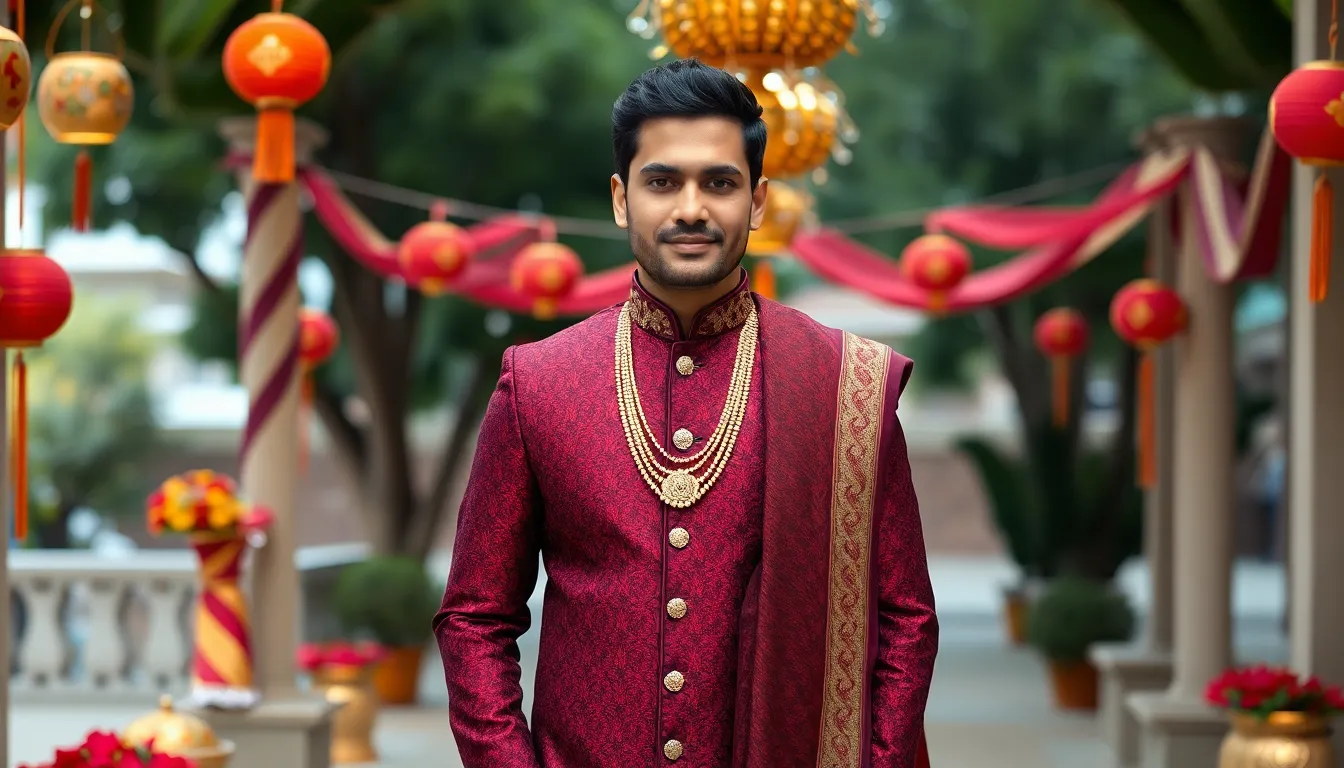
Burgundy brocade sherwanis paired with coordinated woolen shawls represent one of the most sophisticated combinations in traditional menswear. This luxurious ensemble combines the rich texture of brocade fabric with the practical warmth of wool, creating a perfect balance of elegance and functionality.
Seasonal Versatility Advantages
Woolen shawls transform sherwanis into year-round wardrobe staples by providing essential warmth during cooler months. We find that autumn and winter weddings particularly benefit from this pairing, as the shawl maintains style while offering practical temperature control. Spring events can incorporate lighter woolen shawls that add textural interest without causing discomfort.
Evening functions throughout the year showcase the shawl’s versatility, as it provides just enough coverage for air-conditioned venues or outdoor celebrations. The layering opportunity that woolen shawls create allows for easy adaptation to changing temperatures during extended events. Traditional ceremonies often span several hours, making the shawl’s functional benefits invaluable for sustained comfort.
Color Coordination Guidelines
Neutral shades like beige, cream, and off-white create stunning contrasts against burgundy brocade, highlighting the sherwani’s deep richness. We recommend these complementary tones because they enhance rather than compete with the primary garment’s luxurious appearance. Gold accents or light pastel embroidery on the shawl can add sophisticated visual interest while maintaining perfect coordination.
Subtle patterns work exceptionally well when they incorporate metallic threads that catch light beautifully. Resham or Aari embroidery techniques elevate the shawl’s elegance, creating a cohesive look that respects traditional craftsmanship. Avoiding overly bright or clashing colors preserves the outfit’s regal nature and ensures the burgundy brocade remains the focal point.
Draping techniques significantly impact the overall aesthetic, with options ranging from casual shoulder placement to formal chest arrangements. The shawl’s positioning can transform the same outfit from understated elegance to commanding presence, depending on the occasion’s requirements.
Black Silk Sherwani With Statement Embellished Shawl
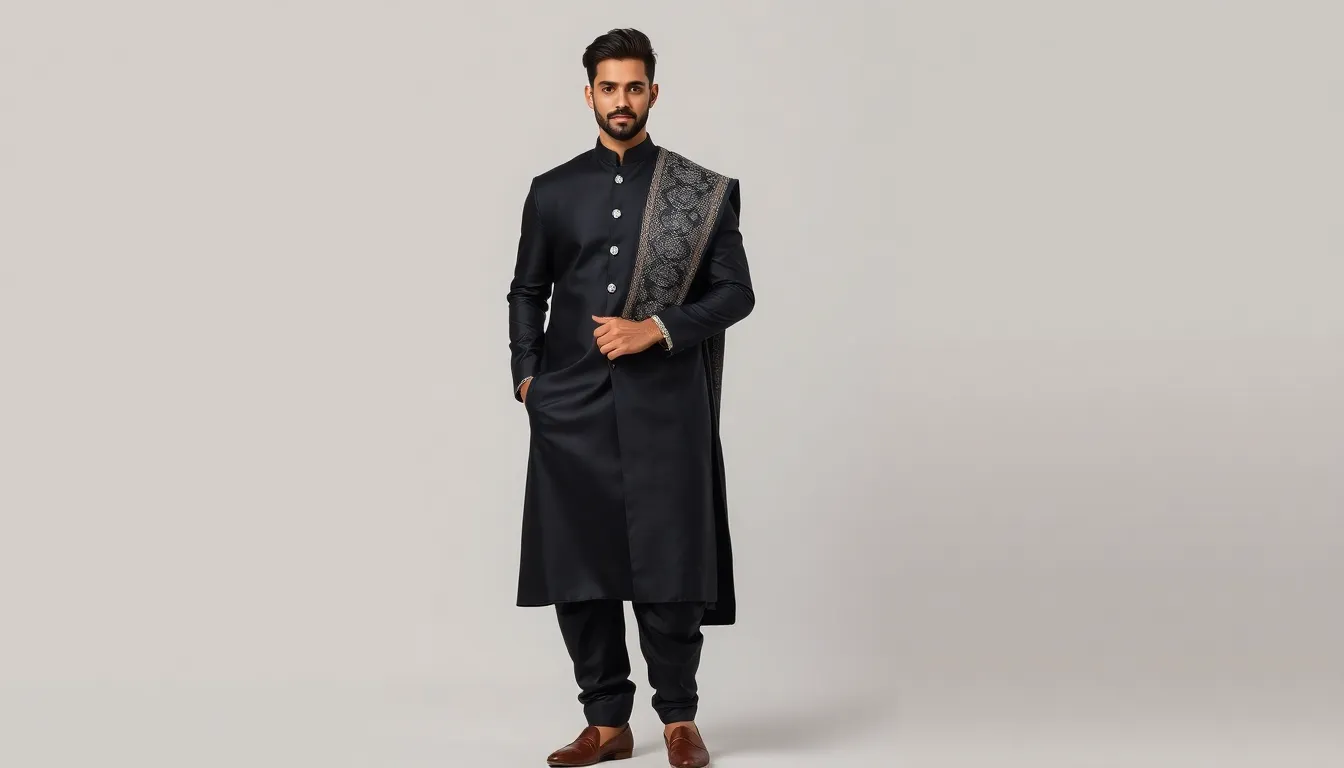
We believe the black silk sherwani paired with a statement embellished shawl creates one of the most striking traditional ensembles for men. This combination blends modern minimalist appeal with cultural richness, making it perfect for formal occasions like weddings and cultural ceremonies.
Modern Minimalist Appeal
Contemporary styling transforms the traditional black silk sherwani into a sleek, modern statement piece. We recommend choosing a plain black sherwani as your base, then adding a single-colored or lightly embroidered shawl to maintain clean lines. This approach keeps the look sophisticated without overwhelming the ensemble.
Subtle details make all the difference when creating a minimalist aesthetic. We suggest focusing on impactful elements like a reversible pocket square in soft tones to add refinement. The contrast between deep black silk and vibrant, ornate shawl details enhances visual impact while maintaining contemporary appeal.
Balance becomes crucial when working with statement pieces. We find that keeping accessories minimal prevents the outfit from appearing overly ornate. The key lies in choosing quality over quantity, allowing the shawl’s embellishments to serve as the focal point.
Accessorizing Recommendations
Pocket squares in coordinating or neutral colors add sophisticated refinement to the black silk sherwani ensemble. We recommend selecting colors that complement rather than compete with your shawl’s embellishments for optimal visual harmony.
Jewelry selection requires careful consideration to avoid overwhelming the statement shawl. We suggest minimal pieces like classic brooches or elegant cufflinks that enhance rather than distract from the overall look. These accessories should complement the shawl’s decorative elements without creating visual competition.
Footwear choices significantly impact the ensemble’s overall impression. We recommend traditional juttis or formal shoes in matching shades to complete the sophisticated appearance. The right footwear grounds the outfit while maintaining its elegant proportions.
Draping techniques offer versatility in styling your embellished shawl. We find that draping over one shoulder creates a casual elegance, while wrapping around the neck provides a more formal appearance. The choice depends on your desired style and comfort level for the exact occasion.
| Accessory Type | Recommended Options | Styling Purpose |
|---|---|---|
| Pocket Squares | Coordinating or neutral colors | Add refinement without overpowering |
| Jewelry | Classic brooches, elegant cufflinks | Enhance without competing |
| Footwear | Traditional juttis, formal shoes | Complete sophisticated appearance |
| Draping Styles | Over shoulder, around neck | Provide styling versatility |
Cream Jacquard Sherwani With Handwoven Cashmere Shawl
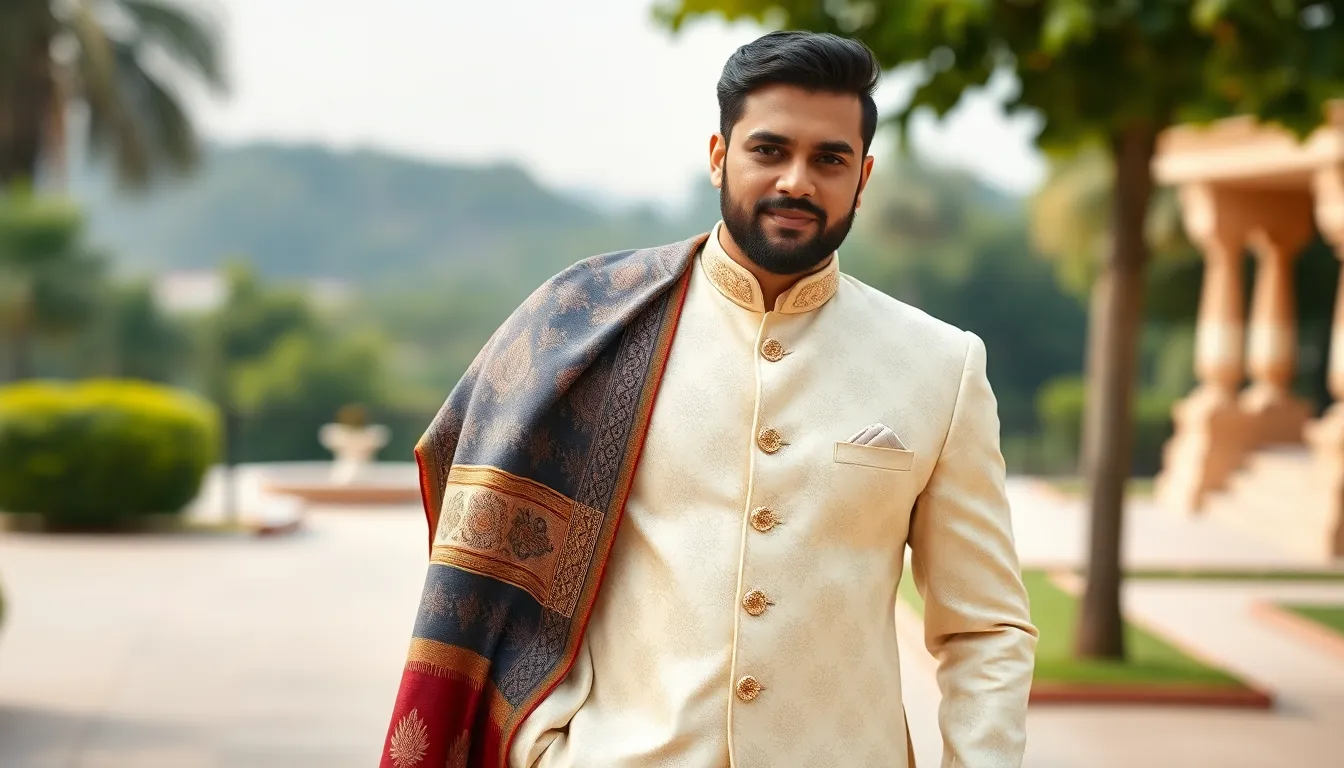
Cream jacquard sherwanis paired with handwoven cashmere shawls represent the pinnacle of sophisticated men’s ethnic wear. This combination showcases intricate weaving patterns that create textured luxury without heavy embroidery while maintaining understated elegance.
Luxury Fabric Pairing Benefits
Elegance meets comfort when we combine the structured beauty of jacquard fabric with the smooth softness of handwoven cashmere. The textured jacquard weaving creates visual depth and interest, while cashmere’s fine fibers provide a feather light yet cozy layer that perfectly contrasts the sherwani’s structured silhouette.
Temperature regulation becomes effortless with this pairing, as cashmere shawls naturally keep you warm during cooler weather events. Evening ceremonies and outdoor celebrations become more comfortable when you’re wrapped in the gentle warmth of quality cashmere.
Visual harmony emerges from the balanced textures of these premium materials. Cream’s versatility allows it to pair beautifully with neutral or pastel shawls, improving the outfit’s sophistication while maintaining that coveted understated luxury aesthetic.
Layered sophistication develops naturally when rich fabrics work together to create depth and interest. We see how the smooth cashmere complements the intricate jacquard patterns, resulting in an elevated look that commands attention without appearing overdone.
Investment Piece Value
Timeless appeal makes both jacquard sherwanis and cashmere shawls worthy investments for any man’s wardrobe. These classic luxury items maintain their relevance across generations, ensuring your investment continues paying dividends for years to come.
Artisanal craftsmanship in handwoven shawls showcases skills often passed down through generations, contributing significantly to their high value and cultural importance. Each piece represents hours of skilled work and traditional techniques that can’t be replicated by machines.
Versatility extends beyond wedding ceremonies to multiple formal events throughout your life. Grooms, wedding guests, and attendees of cultural celebrations can all wear these pieces appropriately, making them cost effective additions to any ethnic wardrobe.
Heritage value develops as well maintained sherwanis and quality cashmere shawls may retain or even increase their worth over time. We often see these pieces becoming treasured family heirlooms that carry both monetary and sentimental value for future generations.
Emerald Green Sherwani With Golden Border Shawl
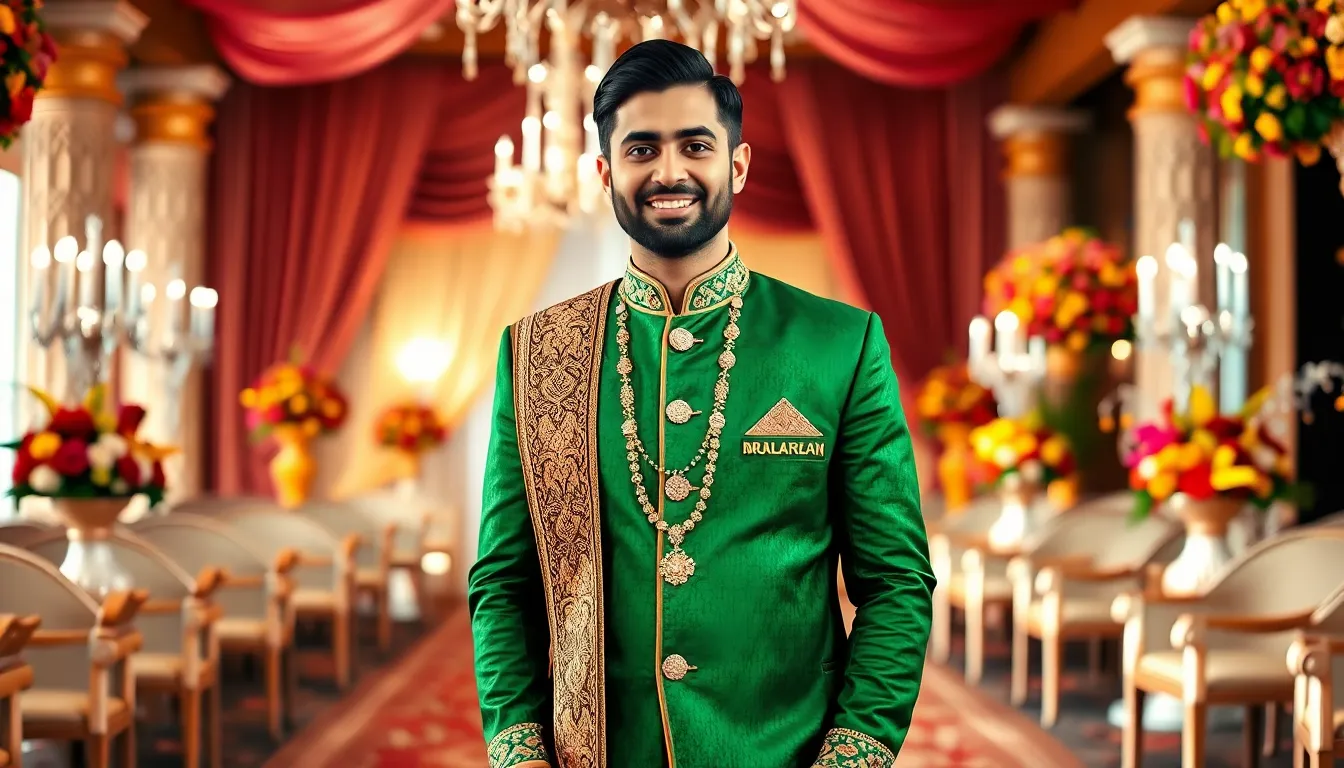
Emerald green sherwanis paired with golden border shawls create one of the most striking combinations in traditional menswear. This vibrant duo transforms any formal occasion into a memorable style statement.
Bold Color Statement Impact
Emerald green serves as the foundation for creating royal magnificence. We recommend this rich jewel tone because it symbolizes prosperity and sophistication across cultures. Emerald’s deep saturation creates visual depth that photographs beautifully under various lighting conditions.
Golden borders amplify the sherwani’s luxury quotient significantly. Metallic accents catch light naturally and add warmth to the cool emerald base. Golden threads woven into intricate patterns create texture that elevates the entire ensemble beyond ordinary formal wear.
Contrast between emerald and gold produces maximum visual impact. These complementary colors create harmony while maintaining distinctiveness. Photography captures this combination exceptionally well, making it ideal for wedding portraits and formal event documentation.
Fabric choice determines how boldly these colors translate. We suggest silk or raw silk sherwanis that hold emerald’s richness without appearing flat. Velvet alternatives provide additional texture depth for evening ceremonies and indoor celebrations.
Cultural Significance Elements
Traditional shawl draping carries ceremonial importance beyond mere aesthetics. We observe that shawls historically represented honor and social status in South Asian traditions. Elders often bestow shawls upon grooms as blessings for prosperity and respect.
Emerald green holds special meaning in various cultural contexts. Islamic traditions associate this color with paradise and divine favor. Hindu ceremonies connect emerald tones to growth, harmony, and new beginnings, making it particularly meaningful for weddings.
Golden embellishments reference ancient textile artistry and craftsmanship. Zardozi work using real gold threads has adorned royal garments for centuries. Modern interpretations maintain this heritage while adapting to contemporary styling preferences.
Regional variations influence how we incorporate these elements. Pakistani styling often features heavier golden work, while Indian preferences may include paisley or floral motifs. Bengali traditions might incorporate subtle geometric patterns that complement the emerald base.
Generational significance makes this combination a family heirloom choice. Quality emerald sherwanis with golden shawls often pass between family members for different celebrations. Investment in superior fabrics and craftsmanship ensures these pieces maintain their beauty across multiple wearings and years.
Choosing The Right Shawl Fabric For Your Sherwani Style

Selecting the perfect shawl fabric requires understanding how different materials complement your sherwani’s texture and occasion. We’ve found that the right fabric pairing can transform your entire ensemble from elegant to extraordinary.
Silk Versus Pashmina Considerations
Silk shawls deliver unmatched elegance with their rich, glossy finish that perfectly complements luxurious sherwanis made from brocade, velvet, or jacquard. The smooth texture of silk pairs beautifully with intricate embroidery work, creating a regal drape that flows naturally over your shoulders.
Pashmina offers superior warmth and comfort through its premium wool construction, making it our top choice for winter weddings and formal occasions. This fabric provides an elegant yet cozy feel that often features traditional Kashmiri embroidery for added cultural authenticity.
Warmth considerations make pashmina ideal for cooler seasons while silk remains more versatile throughout the year but offers less insulation. We recommend considering your event’s climate when choosing between these premium fabrics.
Visual impact differs significantly between these materials as silk shawls exude a glossy, royal appearance perfect for ornate sherwanis, whereas pashmina adds a textured, matte look with traditional embroidery patterns. Weight also plays a crucial role since silk tends to be lighter and more flowing, while pashmina offers a heavier, thicker drape that influences your styling options.
Seasonal Fabric Selection Tips
Winter occasions demand pashmina or embroidered woollen shawls to maintain warmth while improving your sherwani’s grandeur. These heavier fabrics can be draped elegantly over one shoulder or wrapped snugly around the neck for both functionality and sophisticated style.
Summer and warm climate events call for lightweight silk or fine cotton shawls that add sophistication without causing discomfort. Cotton sherwanis paired with rich colored silk shawls in maroon or forest green create perfectly balanced and stylish combinations.
Spring and fall seasons offer flexibility where medium weight fabrics like lightweight pashmina or textured silk work exceptionally well. We suggest choosing fabrics that complement the natural color palette of these transitional seasons.
Event timing within seasons also matters as evening ceremonies often require warmer shawl options regardless of the overall season, while daytime events allow for lighter fabric choices that prioritize comfort and breathability.
Essential Styling Tips For Sherwani With Shawl Combinations
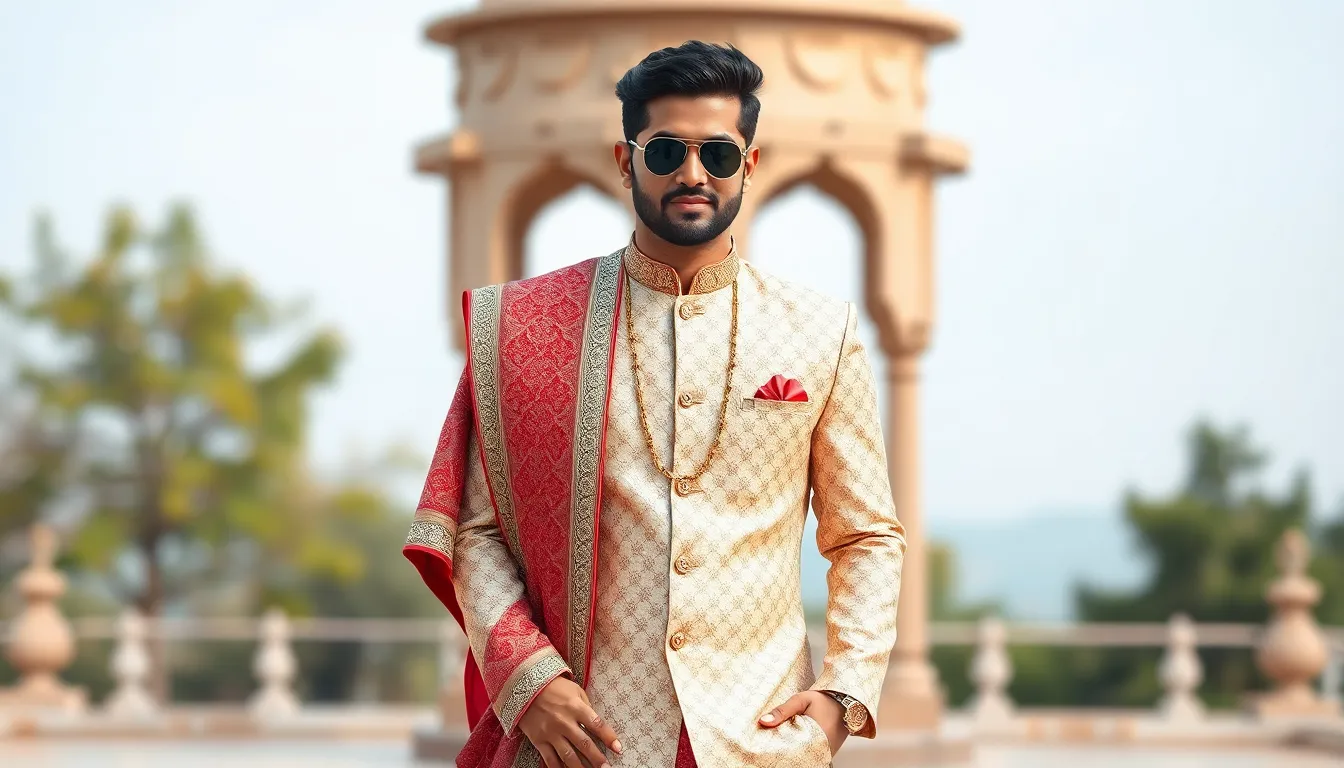
Mastering the art of combining sherwanis with shawls requires attention to exact styling details that elevate your entire look. Understanding proper techniques and accessory coordination ensures you’ll achieve that perfect balance of tradition and sophistication.
Proper Draping Techniques
Single shoulder drapes create the most traditional and formal appearance for sherwani ensembles. Place the shawl on one shoulder and let it fall naturally, either cascading in front or flowing behind your back to highlight the shawl without overwhelming the sherwani’s intricate details.
Over the shoulder draping allows rich fabrics like silk or pashmina to cascade down elegantly, creating a regal appearance that enhances your sherwani’s noble character. This technique works exceptionally well with embroidered Kashmiri patterns, paisley motifs, or bold block prints that add personality and visual depth.
Neck wrapping offers a modern yet sophisticated approach that provides warmth while maintaining elegance throughout your event. Wrap embroidered woolen shawls snugly around the neck for a contemporary casual style that still respects traditional aesthetics.
Wrapped elegance techniques involve draping the shawl around your shoulders for a cozy yet refined appearance, making this style ideal for colder weather ceremonies. Pashmina and light cashmere fabrics work particularly well for this draping method, offering both comfort and visual appeal.
Layering with jackets adds texture and dimension when you pair your sherwani with Nehru jackets or bandhgalas under the shawl. Opt for contrasting colors or heavier fabrics like velvet or brocade for the jacket to create elevated visual interest and sophisticated depth.
Footwear And Accessories Pairing
Traditional Indian footwear like juttis or mojaris complement sherwanis perfectly, offering both authentic style and comfortable wear throughout extended celebrations. These classic shoes maintain cultural authenticity while providing the support needed for wedding ceremonies and formal events.
Modern leather alternatives include polished formal shoes that create a contemporary twist on traditional ensembles without compromising elegance. Choose well crafted leather shoes in black or brown to maintain sophistication while adapting to modern style preferences.
Turban coordination with decorative brooches enhances the royal aesthetic and adds distinctive personality to your sherwani and shawl combination. Select matching turbans that complement your shawl’s color palette to create a cohesive and dignified appearance.
Necklace selections featuring pearl or Kundan beaded designs add charm and sophistication, especially for grooms and special occasion wear. These traditional accessories create focal points that highlight your neckline without competing with your shawl’s embellishments.
Coordinating dupatta additions provide extra elegance and traditional authenticity to complete your sherwani ensemble. Choose dupatta colors that harmonize with both your sherwani and shawl to maintain visual balance and cultural appropriateness throughout your look.
Caring For Your Sherwani With Shawl Investment
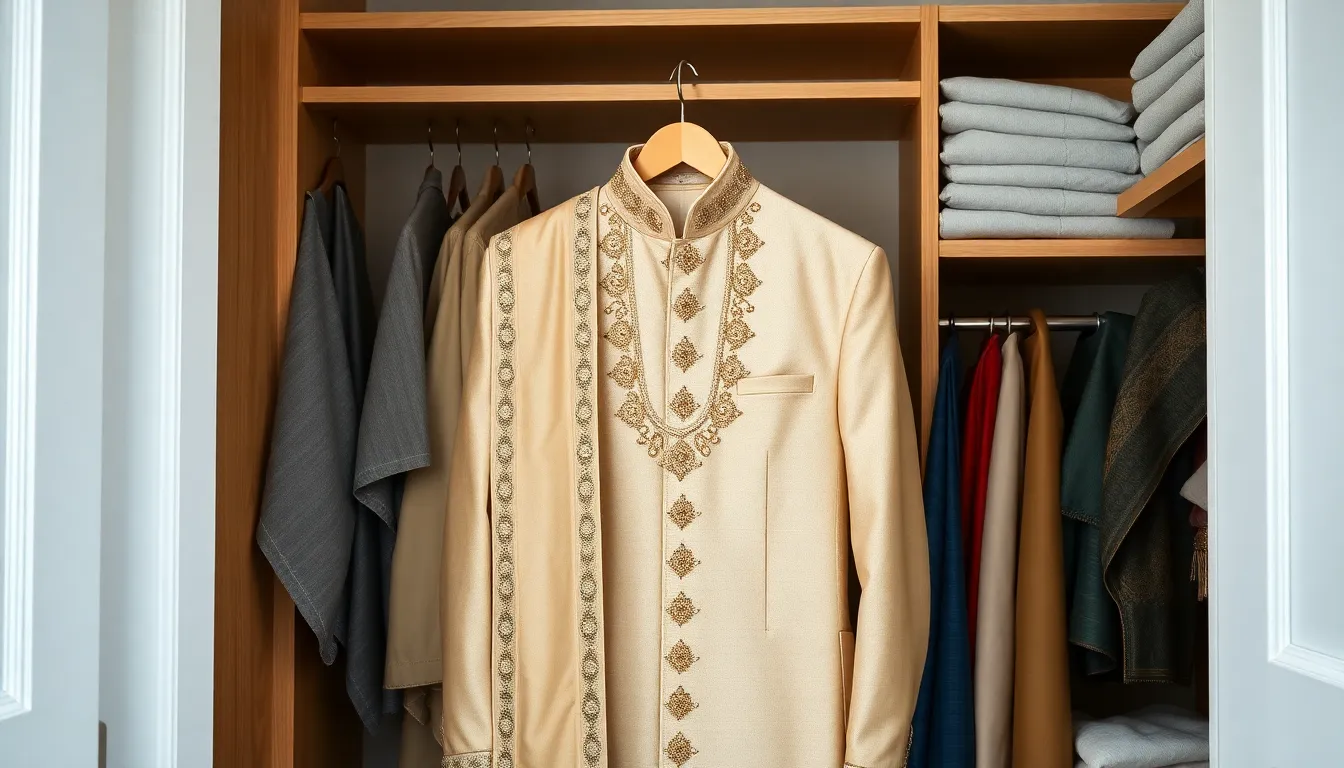
Protecting your sherwani and shawl ensemble requires specialized care to maintain their beauty and value over time. We’ll guide you through the essential practices that preserve these treasured garments for years to come.
Professional Cleaning Requirements
Dry cleaning becomes essential for sherwanis with intricate embroidery, beading, or delicate fabrics like silk and brocade. Professional cleaners understand how to remove stains, sweat, and dirt without damaging the fabric’s integrity or compromising the embellishment work.
Spot cleaning offers the safest approach for minor stains on your sherwani. We recommend using mild cleaning answers targeted specifically at the stain area rather than soaking the entire garment, which could cause color bleeding or fabric distortion.
Avoiding direct sprays protects your investment from unnecessary damage. Never spray perfume or deodorant directly onto the sherwani fabric, as these products can cause permanent discoloration or weaken the fibers over time.
Airing out after cleaning prevents moisture related problems. Allow both your sherwani and shawl to air completely before storing them, as trapped moisture can lead to mildew growth and fabric deterioration.
Storage Best Practices
Cleaning before storage prevents long term damage to your garments. Always ensure your sherwani and shawl are completely clean before putting them away, as residual oils and dirt can attract insects and cause permanent staining.
Breathable covers outperform plastic garment bags in every way. We strongly advise against using plastic covers, which trap moisture and can damage both fabric and embroidery. Instead, choose muslin or cotton cloth covers that allow air circulation.
Sturdy hangers support heavily embroidered sherwanis without causing deformation. Use broad wooden or padded hangers that can handle the weight of ornate garments, preventing stretching and maintaining the original silhouette.
Separate storage keeps your shawl in pristine condition. Store shawls folded in individual breathable fabric bags to prevent thread pulling and maintain the embroidery’s dimensional quality.
Spacious storage areas prevent friction damage between garments. Keep your sherwani and shawl in uncrowded spaces where they won’t rub against other clothing items, which can cause pilling or embellishment loss.
Premium storage answers offer enhanced protection for valuable pieces. Consider investing in specialized storage kits with moisture absorbing properties for long term preservation of your most treasured sherwanis and shawls.
Conclusion
The sherwani with shawl remains an unmatched choice for men seeking sophistication in formal wear. This timeless combination effortlessly bridges traditional heritage with contemporary style making it perfect for today’s discerning gentleman.
We’ve explored how different fabric combinations and draping techniques can transform your look from subtle elegance to regal grandeur. Whether you choose silk luxury or cashmere comfort the key lies in understanding how each element works together.
With proper care and thoughtful styling these investment pieces will serve you well across countless occasions. The sherwani with shawl isn’t just clothing—it’s a statement of refined taste that honors tradition while embracing modern fashion sensibilities.
Frequently Asked Questions
What makes the sherwani and shawl combination timeless?
The sherwani with shawl combination remains popular due to its versatility and elegant appeal. This classic ensemble works perfectly for grooms, wedding guests, and formal event attendees. The combination blends traditional craftsmanship with modern fashion, creating a sophisticated look that transcends generations and suits various occasions from cultural celebrations to formal business events.
Which shawl fabric works best with different sherwani styles?
Silk shawls offer a glossy finish that complements ornate sherwanis beautifully, while pashmina provides warmth and comfort, making it ideal for winter events. For seasonal selection, choose heavier fabrics like pashmina for winter ceremonies and lighter options like silk for summer occasions. Consider the event’s climate and timing when making your fabric choice.
How should I drape a shawl with my sherwani?
Popular draping techniques include the single shoulder drape for formal appearances and over-the-shoulder draping for a regal look. For modern approaches, try neck wrapping or wrapped elegance techniques during colder weather. The draping style can transform your outfit’s appearance, so choose based on the occasion’s formality and your personal comfort.
What accessories complement a sherwani and shawl ensemble?
Choose traditional juttis or modern leather shoes as footwear options. Coordinate turbans and necklaces to enhance the overall aesthetic without overwhelming the outfit. Consider adding a reversible pocket square for subtle detail. Keep accessories minimal to maintain the ensemble’s elegant balance, and ensure they complement rather than compete with the sherwani’s embellishments.
How do I care for my sherwani and shawl properly?
Professional cleaning is essential for intricate garments with embroidery or delicate fabrics. For minor stains, use gentle spot cleaning techniques. Store garments in breathable covers on sturdy hangers to prevent damage. Clean before storage and ensure spacious storage areas to avoid friction damage. Premium storage solutions help preserve these investments long-term.
Which color combinations work best for formal occasions?
Classic ivory sherwanis with embroidered pashmina shawls offer sophisticated elegance. Royal blue velvet sherwanis paired with contrasting silk shawls provide regal charm. Burgundy brocade with coordinated woolen shawls creates sophistication, while black silk sherwanis with embellished shawls offer modern minimalist appeal. Emerald green sherwanis with golden border shawls make striking statement pieces.
Are sherwanis and shawls good long-term investments?
Quality sherwanis and shawls, especially those with superior fabrics and artisanal craftsmanship, often retain or increase their value over time. These pieces can become treasured family heirlooms passed down through generations. The combination of timeless appeal, cultural significance, and exceptional craftsmanship makes them worthwhile investments for any ethnic wardrobe.
What’s the cultural significance of wearing shawls with sherwanis?
In South Asian traditions, shawls represent honor and social status. The combination carries deep cultural meaning, with emerald green symbolizing prosperity and sophistication, while golden borders enhance the ensemble’s luxurious impact. This traditional pairing respects cultural dress codes while allowing for personal style expression at formal and ceremonial occasions.

